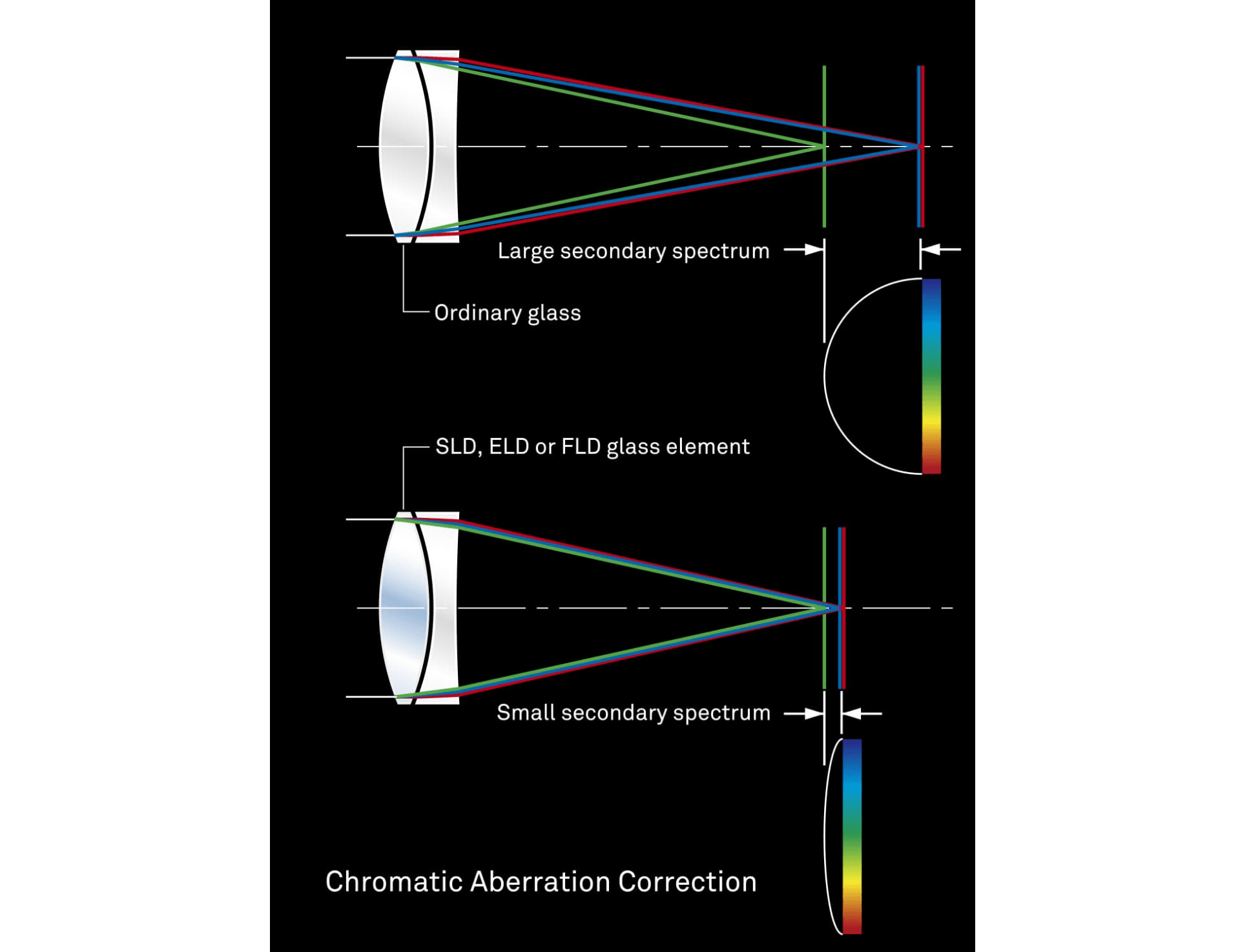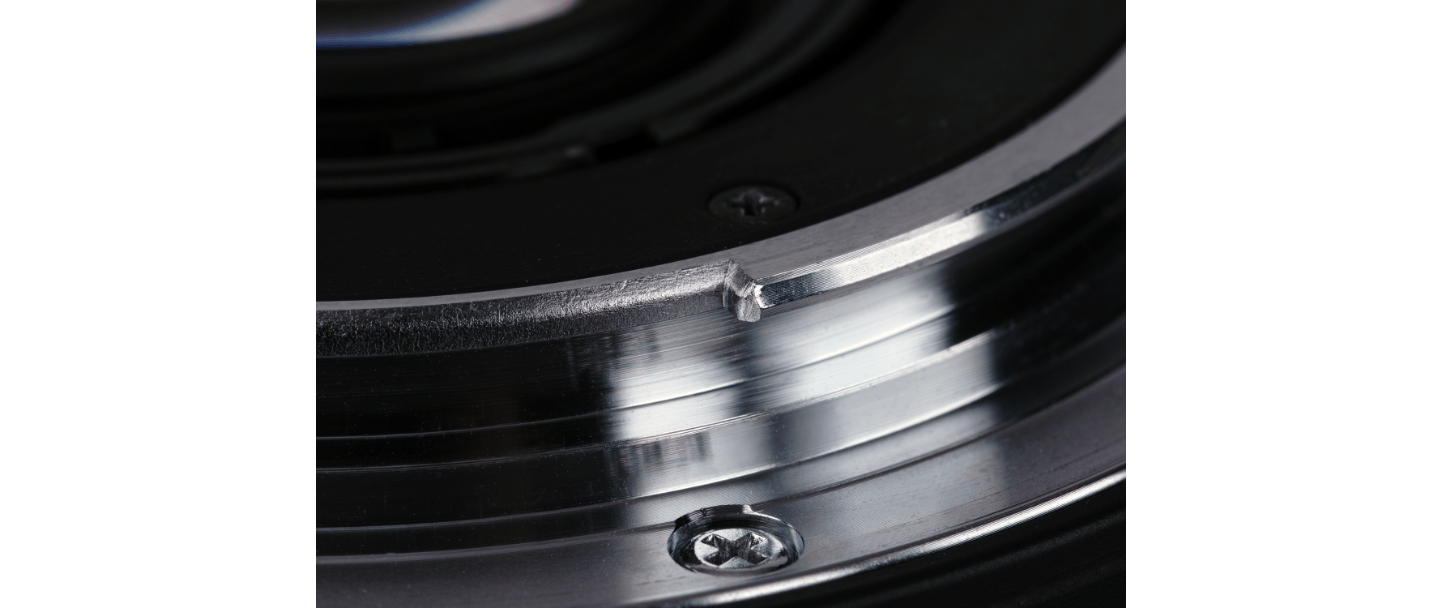14-24mm F2.8 DG HSM | A

• Full-frame lens met APS-C-compatibiliteit
• Lichtsterk (F2.8) over het gehele zoombereik
• Stof- en spatwaterdichte constructie met weerbestendige afdichting
• Vrijwel geen vervorming bij focus op oneindig
Outstanding Art line image quality
Designed to team up with 50-megapixel-plus cameras
Designed to team up with 50-megapixel-plus cameras and offer top-level optical performance throughout the zoom range, the 14-24mm F2.8 DG HSM | Art incorporates three FLD glass elements, three SLD glass elements, and three aspherical lens elements, including one large-diameter aspherical element. Effective distribution of these high-refractive-index glass elements further enhances the corrective effect of the FLD and SLD glass. This optical system minimizes transverse chromatic aberration and other optical aberrations, resulting in outstanding high-resolution image quality.
The first element in the optical system is a large-diameter aspherical lens. Optimizing the power distribution of this and the other lens elements minimizes distortion to 1% or lower.* As a result, points of light appear as points without streaking from the center of the image to the edge, and the light volume is also abundant throughout the frame. In addition, simulations performed from the design stage onward have helped minimize flare and ghosting. In combination, these technologies ensure excellent ultra-wide-angle performance.
* At infinity focus
Exclusive low-dispersion glass
The degree to which light is refracted by glass depends on the light’s wavelength. This fact causes different colors of light to focus at slightly different points. The result is chromatic aberration, the color fringing that is particularly noticeable in telephoto lenses. Most chromatic aberration can be removed by combining a high-refractivity convex lens element with a low-refractivity concave element. Yet residual chromatic aberration known as “secondary spectrum” may still remain. To minimize this secondary spectrum, which can be a serious issue with conventional lenses, Sigma lenses feature up to three types of exclusive low-dispersion glass offering superior performance: ELD (Extraordinary Low Dispersion), SLD (Special Low Dispersion) and FLD (“F” Low Dispersion). In particular, FLD glass offers ultra-low dispersion in combination with high transmittance and the anomalous dispersion characteristics of fluorite. Meticulous deployment of these types of exclusive low-dispersion glass and optimization of power distribution gives Sigma lenses superlative image rendition undiminished by residual chromatic aberration.


Designed to minimize flare and ghosting
From an early stage in the lens design process, flare and ghosting have been measured to establish an optical design resistant to strong incident light sources such as backlighting. Sigma’s Super Multi-Layer Coating reduces flare and ghosting to help photographers produce sharp and high contrast images even in backlit conditions.


Compatible with Canon Lens Aberration Correction*
The Canon mount lens is compatible with the Canon Lens Aberration Correction function. Matching the optical characteristics of the lens, these functions perform in-camera corrections of peripheral illumination, chromatic aberrations, distortion, and more.
The Canon mount lens is compatible with the Canon Lens Aberration Correction function. Matching the optical characteristics of the lens, these functions perform in-camera corrections of peripheral illumination, chromatic aberrations, distortion, and more.
* Function not available on all Canon cameras. Further, available corrections may vary by Canon camera model.
(*)Canon camera compatibility
The SGV interchangeable lens for Canon EF mount supports the "lens optical correction" installed in the following cameras.
CANON camera compatibility
EOS R5※, EOS R6※, EOS R※, EOS RP※, EOS Ra※, EOS-1D X Mark III,EOS 1DX mark Ⅱ, EOS 5Ds, EOS 5DsR, EOS 5D mark Ⅳ, EOS 6D mark Ⅱ, EOS 90D, EOS 80D, EOS 8000D(EOS Rebel T6s, EOS 760D), EOS 9000D(EOS 77D), EOS Kiss X8i(EOS Rebel T6i, EOS 750D), EOS Kiss X9i(EOS Rebel T7i, EOS 800D), EOS Kiss X9(EOS Rebel SL2, EOS 200D), EOS Kiss X10i, EOS Kiss X10
※ For SGV interchangeable lenses released before 2017* , it is necessary that the lens firmware is updated to Ver.2.00 or later.
* The release year can be confirmed by the edition number (A017, C015, etc.) engraved on the lens barrel.
※After setting the Digital Lens Optimizer to [OFF], set the "Peripheral Illumination Correction", "Chromatic Aberration Correction", and "Distortion Correction" of the "Lens Aberration Correction" function to [ON] to achieve the appropriate corrections in accordance with the optical characteristics of each lens.
Professional specifications
Allowing photographers to work in all types of weather
Like Sigma’s Sports line lenses, the 14-24mm F2.8 DG HSM | Art features a highly effective dust and splash resistant structure* with special sealing at the mount connection, manual focus ring, zoom ring, and cover connection, allowing photographers to work in all types of weather. In addition, the front of the lens is protected by a water- and oil-repellent coating that makes cleaning easy. The high-speed, high-accuracy autofocus helps photographers react in an instant to get those special shots.
* Although this construction allows the lens to be used in light rain, it is not the same as being waterproof.


Fast AF with full-time manual focus
Full-time manual focus function allows the lens to be switched to manual focus simply by rotating the focus ring.
Note: The operation of full-time MF may vary based on mount type.
High-precision, rugged brass bayonet mount
The brass mount combines high precision with rugged construction. Its treated surfaces and enhanced strength contribute to the exceptional durability of the lens.


Rounded diaphragm
The 9-blade rounded diaphragm creates an attractive blur in the out-of-focus areas of the image.


Nikon electromagnetic diaphragm mechanism included
The lens for the Nikon camera includes the electromagnetic diaphragm mechanism and is able to receive the appropriate signals from the camera body. This feature ensures precision diaphragm control and stable Auto Exposure (AE) performance during continuous shooting.
(*)Nikon camera compatibility
Lenses for Nikon F mount with an electromagnetic diaphragm mechanism can be used with the following cameras.
Z7Ⅱ※,Z7※,Z6Ⅱ※,Z6※,Z5※,Z50※,D6, D5, D4S, Df, D850, D810, D810A, D780, D750, D610, D500, D7500, D7200, D7100, D5600, D5500, D5300, D5200, D5100, D5000, D3500, D3400, D3300, D3200, D3100
※Can be used with the Nikon "Mount Adapter FTZ" attached
Before using with one of the cameras listed below, please update the lens to the latest firmware version.
D4, D3X, D3S, D3, D800, D800E, D700, D600, D300S, D300, D7000
* The lens cannot be used with the cameras not listed above (including film single‐lens reflex cameras).
Introducing new Front Conversion Service
Today’s virtual reality creators favor multi-camera videography that leverages the capability of ultra-wide-angle lenses. Addressing this trend, Sigma is offering the new Front Conversion Service (charges apply), in which Sigma converts the petal-type hood of the 14-24mm F2.8 DG HSM | Art lens to an exclusive round component. This altered front structure allows the lens to be deployed with greater freedom in multi-camera VR videography. The new front also helps prevent the lens from interfering with other lenses or from casting a visible shadow. The use of this service has no impact on the validity of the product warranty.


Front Conversion Service
| Productlijn | Art | |
|---|---|---|
| Youtube Videos | ||
| Youtube Channel Link | https://www.youtube.com/channel/UCj0Y0mbE0gdB3Ou4zxeWeoQ/featured | |
| Instagram Widget | ||
| Klevu Image | /a/0/a018_14_24_28_basic_01.png | |
| Lensconstructie | 17 Elements in 11 Groups | |
| Lens Type | Wide Angle | |
| Sensor Size | Full Frame | |
| Beeldhoek | 114.2° - 84.1° | |
| Aantal diafragmalamellen | 9 (Rounded Diaphragm) | |
| Minimaal diafragma | F22 | |
| Minimale scherpstelafstand | 26-28 cm / 10.2-11.0 in * At 24mm end of the zoom range | |
| Maximale vergroting | 1:5.4 | |
| Afmetingen (diameter x lengte) | ||
| Gewicht (gram) | 1,150 g / 40.6 oz | |
| Filtermaat | n/a | |
| Edition number | A017 | |
| EAN-code | Canon EF 085126212544 |
|
Outstanding Art line image quality
Designed to team up with 50-megapixel-plus cameras
Designed to team up with 50-megapixel-plus cameras and offer top-level optical performance throughout the zoom range, the 14-24mm F2.8 DG HSM | Art incorporates three FLD glass elements, three SLD glass elements, and three aspherical lens elements, including one large-diameter aspherical element. Effective distribution of these high-refractive-index glass elements further enhances the corrective effect of the FLD and SLD glass. This optical system minimizes transverse chromatic aberration and other optical aberrations, resulting in outstanding high-resolution image quality.
The first element in the optical system is a large-diameter aspherical lens. Optimizing the power distribution of this and the other lens elements minimizes distortion to 1% or lower.* As a result, points of light appear as points without streaking from the center of the image to the edge, and the light volume is also abundant throughout the frame. In addition, simulations performed from the design stage onward have helped minimize flare and ghosting. In combination, these technologies ensure excellent ultra-wide-angle performance.
* At infinity focus
Exclusive low-dispersion glass
The degree to which light is refracted by glass depends on the light’s wavelength. This fact causes different colors of light to focus at slightly different points. The result is chromatic aberration, the color fringing that is particularly noticeable in telephoto lenses. Most chromatic aberration can be removed by combining a high-refractivity convex lens element with a low-refractivity concave element. Yet residual chromatic aberration known as “secondary spectrum” may still remain. To minimize this secondary spectrum, which can be a serious issue with conventional lenses, Sigma lenses feature up to three types of exclusive low-dispersion glass offering superior performance: ELD (Extraordinary Low Dispersion), SLD (Special Low Dispersion) and FLD (“F” Low Dispersion). In particular, FLD glass offers ultra-low dispersion in combination with high transmittance and the anomalous dispersion characteristics of fluorite. Meticulous deployment of these types of exclusive low-dispersion glass and optimization of power distribution gives Sigma lenses superlative image rendition undiminished by residual chromatic aberration.


Designed to minimize flare and ghosting
From an early stage in the lens design process, flare and ghosting have been measured to establish an optical design resistant to strong incident light sources such as backlighting. Sigma’s Super Multi-Layer Coating reduces flare and ghosting to help photographers produce sharp and high contrast images even in backlit conditions.


Compatible with Canon Lens Aberration Correction*
The Canon mount lens is compatible with the Canon Lens Aberration Correction function. Matching the optical characteristics of the lens, these functions perform in-camera corrections of peripheral illumination, chromatic aberrations, distortion, and more.
The Canon mount lens is compatible with the Canon Lens Aberration Correction function. Matching the optical characteristics of the lens, these functions perform in-camera corrections of peripheral illumination, chromatic aberrations, distortion, and more.
* Function not available on all Canon cameras. Further, available corrections may vary by Canon camera model.
(*)Canon camera compatibility
The SGV interchangeable lens for Canon EF mount supports the "lens optical correction" installed in the following cameras.
CANON camera compatibility
EOS R5※, EOS R6※, EOS R※, EOS RP※, EOS Ra※, EOS-1D X Mark III,EOS 1DX mark Ⅱ, EOS 5Ds, EOS 5DsR, EOS 5D mark Ⅳ, EOS 6D mark Ⅱ, EOS 90D, EOS 80D, EOS 8000D(EOS Rebel T6s, EOS 760D), EOS 9000D(EOS 77D), EOS Kiss X8i(EOS Rebel T6i, EOS 750D), EOS Kiss X9i(EOS Rebel T7i, EOS 800D), EOS Kiss X9(EOS Rebel SL2, EOS 200D), EOS Kiss X10i, EOS Kiss X10
※ For SGV interchangeable lenses released before 2017* , it is necessary that the lens firmware is updated to Ver.2.00 or later.
* The release year can be confirmed by the edition number (A017, C015, etc.) engraved on the lens barrel.
※After setting the Digital Lens Optimizer to [OFF], set the "Peripheral Illumination Correction", "Chromatic Aberration Correction", and "Distortion Correction" of the "Lens Aberration Correction" function to [ON] to achieve the appropriate corrections in accordance with the optical characteristics of each lens.
Professional specifications
Allowing photographers to work in all types of weather
Like Sigma’s Sports line lenses, the 14-24mm F2.8 DG HSM | Art features a highly effective dust and splash resistant structure* with special sealing at the mount connection, manual focus ring, zoom ring, and cover connection, allowing photographers to work in all types of weather. In addition, the front of the lens is protected by a water- and oil-repellent coating that makes cleaning easy. The high-speed, high-accuracy autofocus helps photographers react in an instant to get those special shots.
* Although this construction allows the lens to be used in light rain, it is not the same as being waterproof.


Fast AF with full-time manual focus
Full-time manual focus function allows the lens to be switched to manual focus simply by rotating the focus ring.
Note: The operation of full-time MF may vary based on mount type.
High-precision, rugged brass bayonet mount
The brass mount combines high precision with rugged construction. Its treated surfaces and enhanced strength contribute to the exceptional durability of the lens.


Rounded diaphragm
The 9-blade rounded diaphragm creates an attractive blur in the out-of-focus areas of the image.


Nikon electromagnetic diaphragm mechanism included
The lens for the Nikon camera includes the electromagnetic diaphragm mechanism and is able to receive the appropriate signals from the camera body. This feature ensures precision diaphragm control and stable Auto Exposure (AE) performance during continuous shooting.
(*)Nikon camera compatibility
Lenses for Nikon F mount with an electromagnetic diaphragm mechanism can be used with the following cameras.
Z7Ⅱ※,Z7※,Z6Ⅱ※,Z6※,Z5※,Z50※,D6, D5, D4S, Df, D850, D810, D810A, D780, D750, D610, D500, D7500, D7200, D7100, D5600, D5500, D5300, D5200, D5100, D5000, D3500, D3400, D3300, D3200, D3100
※Can be used with the Nikon "Mount Adapter FTZ" attached
Before using with one of the cameras listed below, please update the lens to the latest firmware version.
D4, D3X, D3S, D3, D800, D800E, D700, D600, D300S, D300, D7000
* The lens cannot be used with the cameras not listed above (including film single‐lens reflex cameras).
Introducing new Front Conversion Service
Today’s virtual reality creators favor multi-camera videography that leverages the capability of ultra-wide-angle lenses. Addressing this trend, Sigma is offering the new Front Conversion Service (charges apply), in which Sigma converts the petal-type hood of the 14-24mm F2.8 DG HSM | Art lens to an exclusive round component. This altered front structure allows the lens to be deployed with greater freedom in multi-camera VR videography. The new front also helps prevent the lens from interfering with other lenses or from casting a visible shadow. The use of this service has no impact on the validity of the product warranty.


Front Conversion Service
Lens Construction
Geometrical MTF Chart
Diffraction MTF Chart
Dust and Splash Resistant Structure
This lens features a highly effective dust and splash resistant structure with special sealing at the mount connection, manual focus ring, zoom ring, and cover connection.
*Although this construction allows the lens to be used in light rain, it is not the same as being waterproof, so please prevent large amounts of water from splashing on the lens. It is often impractical to repair the internal mechanism, lens elements and electric components if they are damaged by water.
Nikon electromagnetic diaphragm mechanism
The Nikon mount version of this lens includes an electromagnetic diaphragm mechanism that allows it to receive the appropriate signals from the camera body. This feature ensures precision diaphragm control and stable Auto Exposure (AE) performance during continuous shooting.
High-precision, rugged brass bayonet mount
The brass mount combines high precision with rugged construction. Its treated surfaces and enhanced strength contribute to the exceptional durability of the lens.
Water and oil repellent coating
Incorporates a water and oil-repellent coating that allows water to be wiped away easily and prevents oil and fat from sticking to the surface, even in challenging shooting conditions. At the same time, the maintenance of the lens surface becomes easier.
HSM (Hyper Sonic Motor)
The Hyper Sonic Motor (HSM) is an original SIGMA development that uses ultrasonic waves to drive the autofocus mechanism. Its extremely quiet operation helps avoid disturbing photographic subjects. High torque and speed assure rapid autofocus response. SIGMA uses two types of HSM: ring HSM and micro HSM. The Ring HSM configuration permits manual fine tuning of focus (manual override) by turning the focusing ring after autofocus is complete.
Rounded diaphragm
The polygonal shape of a conventional iris dia phragm causes out-of-focus light points to appear polygonal. A rounded diaphragm is designed to pro duce rounded out-of-focus light points when opened to near maximum aperture. This creates attractive bokeh effects in many situations, such as when pho tographing a subject against an out-of-focus surface of water from which light is being reflected.
Exclusive low-dispersion glass
The degree to which light is refracted by glass depends on the light's wavelength. This fact causes different colors of light to focus at slightly different points. The result is chromatic aberration, the color fringing that is particularly noticeable in telephoto lenses. Most chromatic aberration can be removed by combining a high-refractivity convex lens element with a low-refractivity concave element. Yet residual chromatic aberration known as "secondary spectrum" may still remain. To minimize this secondary spectrum, which can be a serious issue with conventional lenses, SIGMA lenses feature up to three types of exclusive low-dispersion glass offering superior performance: ELD (Extraordinary Low Dispersion), SLD (Special Low Dispersion) and FLD ("F" Low Dispersion). In particular, FLD glass offers ultra-low dispersion in combination with high transmittance and the anomalous dispersion characteristics of fluorite. Meticulous deployment of these types of exclusive low-dispersion glass and optimization of power distribution gives SIGMA lenses superlative image rendition undiminished by residual chromatic aberration.

